The 6th Laser Display and Lighting Conference (LDC ’17) was held April 19th – 21st at the Pacifico Yokohama convention complex in Yokohama, Japan. While ‘lighting’ was in the conference title, the focus was on the lasers (and to a lesser extent, LEDs) and displays, especially projection displays. Only three papers out of the 46 presented applied solely to lighting.
The conference had 93 attendees from 9 different countries, with 68 of the attendees from Japan. LDC ’17 was one of 12 specialized international conferences that were part of the Optics & Photonics International Congress 2017 (OPIC ’17), produced by the Optical Society of Japan (OSJ) and its partners. OPIC is an annual event similar to the SPIEs Photonics West and the SPIE is an international partner of the OSJ. OPIC ’17 had 1012 participants, with 37% of them from outside Japan.
OPIE ’17 Registration (Credit: OPIE)
OPIC ’17 was co-located with the Optics & Photonics International Exhibition (OPIE ’17). OPIE ’17 had 351 exhibitors in a total of 472 booths. 45 of these exhibitors were from 11 countries overseas. There were 15,214 attendees at the 3-day exhibition. The exhibition included 11 advanced technology seminars and 11 exhibitor seminars.
In his opening address for LDC ’17, Conference Chair Kazuo Kuroda from Utsunomiya University said, “The laser display technology is steadily developing from large displays for movie theaters to ultra-small displays for wearable devices. The laser lighting technology is also developing, especially for automotive headlamps. LDC is intended to provide a central forum for the update and review of scientific and technical information on laser display and lighting covering a wide range of fields from fundamental research to systems and applications.”
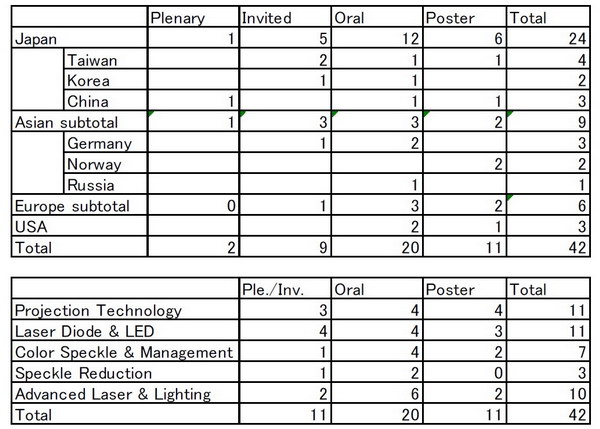 LDC ’17 Program Statistics by Country of Origin and Topic. (Credit LDC)
LDC ’17 Program Statistics by Country of Origin and Topic. (Credit LDC)
LDC ’17 was organized into nine sessions. The program can be downloaded here. A brief review of each session is given below.
LDC & LEDIA Joint Session
This session was joint with another one of the 12 specialized conferences at OPIC ’17, The 5th International Conference on Light-Emitting Devices and Their Industrial Applications (LEDIA ’17). All six papers in this session were invited papers. Four of the six papers in this session focused on high-output InGaN devices. Of those four, three focused on the evaluation of high-power GaN substrates, lasers and LEDs. The fourth, with 7 authors from National Taiwan University and PlayNitride Inc. discussed an epitaxial technique to increase the output of blue lasers. They said with commercial TO-9 packaging, the technique allowed a maximum output power of 1.3W driving at 2.2A. The peak WPE was 9.5% driving at 1.6A.
The fifth paper was from three authors at Chiba University and discussed RGB holographic displays that used a single LCD and computed holograms. The final paper in the session discussed using laser projection for projection mapping applications.
LDC1: Plenary Session
The Plenary session included two papers and dealt more with markets than technology. The first paper was from Shigeki Okauchi and his co-author Atsutomo Hama at Nichia. Okauchi-san traced the history of the GaN laser diode and applications from the first GaN LD in 1995 that emitted at 410nm through present, high power GaN lasers suited for displays. He pointed out the early applications of blue lasers, including Blu-Ray, lithography and bio-medical applications required LDs with 10mW – 100mW but display applications require much higher outputs, at least a couple of watts. 6P-3D laser cinema requires, perhaps, the highest outputs of any current laser projection application. 6P-3D also requires the narrow bandwidth provided by lasers.
According to Fergal Shevlin, who attended his talk, the overall tone was really positive about the possibilities of laser diodes (LD) in projection displays, LCD backlights, HUDs, HMDs, and automotive headlights. Okauchi-san said Nichia has sold 160M LDs over 17 years and the company has a 95% global share of blue LD in projection displays. They plan to ship 30M LDs in 2017. Some of these LDs are up to 6 W in optical power and he added they already have a 1 W Green LD. (note: The commercially available 1W green LD from Nichia is 525nm, not 532.) In the future, he expects green LDs to be more powerful and to have better WPE.
Okauchi-san pointed out the problem with green lasers and the need for 532nm output to match the Rec. 2020 color space. He said, “Nichia succeeded in CW emission at 0.9W at 532nm wavelength in the developing phase and expected the mass production of the green LD in the near future.” This was in the printed version of his paper which is at least seven months old now. Time marches on!
The second paper in the Plenary session was titled “Laser Phosphor based projector” and was presented by Fei Hu of Appotronics. Unfortunately, I have been unable to get hold of a copy of the paper or even its abstract so I can not report on what he said.
LDC2: Projection Technology
This session included four papers on projection technology. The first paper was titled “Performance of RGB laser based projection for Video walls” was presented by Peter Hickl of Barco. It focused on the advantages of lasers over LED for rear-projection video cubes for applications such as control rooms. These include higher brightness, higher contrast and lower power consumption, as shown in the table. With performance like this, just as LEDs replaced lamps in this market, we can expect lasers to eventually replace LEDs.
 Barco’s rear projection laser engine and its performance. (Credit: OSJ)
Barco’s rear projection laser engine and its performance. (Credit: OSJ)
A paper from Jari O. Honkanen and P. Selvan Viswanathan at MicroVision Inc. was titled “Laser Beam Scanning Short Throw Displays and an Exploration of Laser-Based Virtual Touchscreens.” This discussed applications of the MicroVision laser scanning technology not only for image projection but for creation of virtual touch screens. The two functions could be combined to create interactive images.
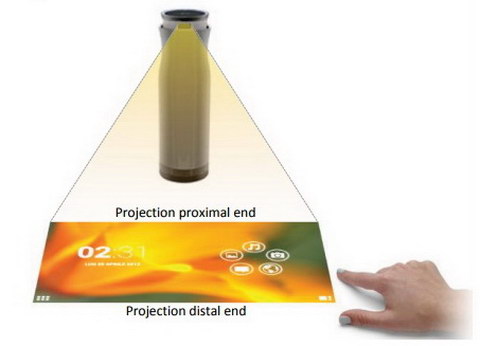 MicroVision’s interactive short throw projection tabletop display with a virtual touchscreen. (Credit: OSJ)
MicroVision’s interactive short throw projection tabletop display with a virtual touchscreen. (Credit: OSJ)
Makoto Suzuki, and his four co-authors from QDLaser, Inc. gave a paper titled “Image Quality of Retinal Projection Laser Eyewear: How to Achieve High Resolution and Free Focus in Proper Balance.” This involved a scanned laser projector built into eyewear that would project directly on the retina for AR applications.
The final paper in this session was titled “Electro-Optic Bragg Diffraction Type Spatial Light Modulator Using Periodically Poled Structures for Laser Displays” was from Yuta Hayashi and three co-authors at Osaka University. This system involves Bragg diffraction rather than a moving mirror to spatially modulate the output of a laser beam. Since no mechanical motion is involved, it can be (in theory) faster and therefore higher resolution than a scanned system such as MicroVision’s.
LDCp3: Poster Session
There were 11 papers presented at the LDC poster session. The poster session was joint with all 12 conferences at OPIC ’17.
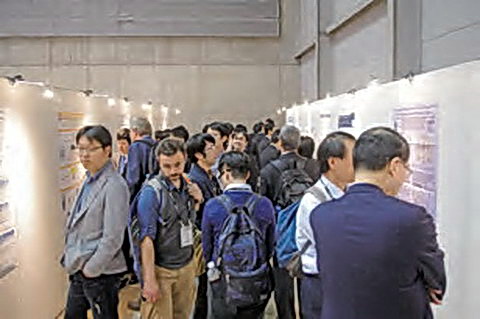 Poster Papers at OPIC ’17 (Credit OPIE)
Poster Papers at OPIC ’17 (Credit OPIE)
As is typical of poster papers, these 11 papers were highly technical and primarily of interest for specialists. For example, six authors from the University College of Southeast Norway and Barco Fredrikstad presented a paper titled “Comparative study of blue diode laser-driven Ce:YAG, Ce:LuAG, Ce:GAGG, and Ce:GdYLuAG single crystal phosphors in application of high power lightning and display technologies.” Five of the authors also presented a second poster paper titled “Laser Driven Phosphor Light Engine for High Lumen DMD Projector.”
LDC4: Laser Diode & LED
There were six papers in this session, including two invited papers. Two of the papers focused on high-power GaN blue/UV lasers, two on red lasers and one on an optical technique that could significantly increase the power output of any laser diode, although the author, J. Kinoshita from Osaka University, used GaN as an example of how to use the technique. The final paper was an invited paper presented by Kenneth Tai, Chairman and CEO of Jasper Display Corporation that discussed his company’s X-on Silicon Digital Electro-optics Platform. This X-on Silicon platform is a backplane design he said could be used for LCoS, Micro LEDs on silicon, OLEDs on silicon and other photonics applications.
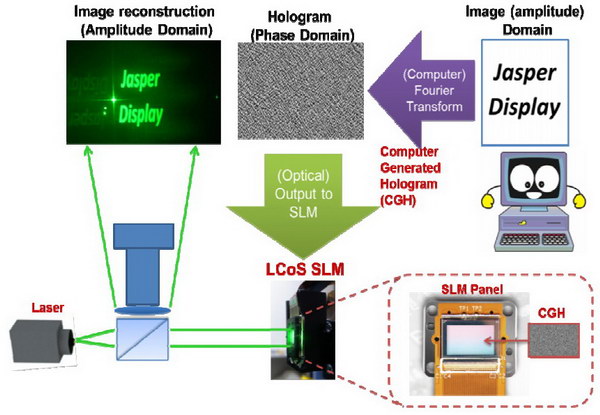 Example of the X-on Silicon Platform used for a LCoS device in a holographic projector (Credit: OSJ)
Example of the X-on Silicon Platform used for a LCoS device in a holographic projector (Credit: OSJ)
Another interesting paper in this session was titled “Master Oscillator Power Amplifier [MOPA] Concepts with Nearly Diffraction-Limited Watt-Level Continuous Wave Emission at 635 nm for Laser Projection” by N. Werner and his seven co-authors at the Ferdinand-Braun-Institut in Berlin. The title is actually a sufficient summary of the paper for this report. A related paper in session LDC7 discussed how the 1M long optical system in the image (below left) could be fit into the small 55mm butterfly package (below right).
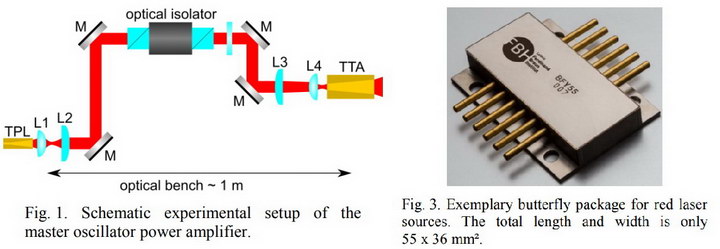 MOPA Red Laser from the Ferdinand-Braun-Institut (Credit: OSJ)
MOPA Red Laser from the Ferdinand-Braun-Institut (Credit: OSJ)
LDC5: Color Speckle & Management
Four of the five papers in this session were primarily related to the evaluation of laser speckle, especially in full color images. These are important topics but, like the poster papers, are best left to specialists in measuring laser speckle and color.
The fifth paper was titled “Efforts to realize wide color gamut, high brightness projector” and was by Masaya Masuda and two co-authors from the Seiko Epson Corporation. This was a description of the technology behind the 12,000 lumen L25000U laser-phosphor 3LCD projector. Like Barco’s rear projection units, the projector had higher output and lower power consumption than the previous generation projector. Since the previous generation in this case was a lamp-based projector, the unit also had much longer light source lifetime. While the Epson authors thought laser-phosphor was right for now, they concluded their paper by “Considering the RGB laser as a promising light source in the future, we will continue to develop to provide high brightness projectors with long lifetime and wide color gamut.”
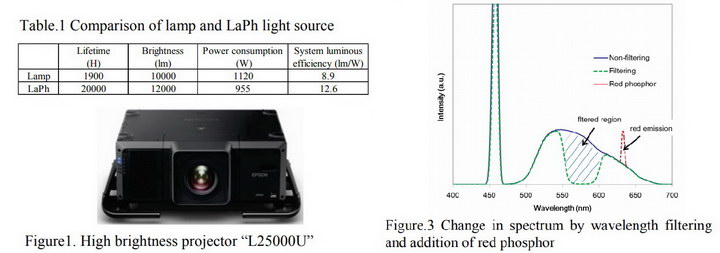 Epson High-Brightness Laser-Phosphor 3LCD Projector (Credit: OSJ)
Epson High-Brightness Laser-Phosphor 3LCD Projector (Credit: OSJ)
LDC6: Speckle Reduction
The three papers in this session were also speckle related. Two of them discussed techniques to reduce speckle and the third was more about speckle measurement and would have fit well in the previous session if there had been space. Again, do to their highly technical nature, they are best left to specialists.
LDC7: Advanced Laser & Lighting
The six papers in this session were a grab-bag of papers about high power lasers for displays and illumination. The first paper was an invited paper from the Ferdinand-Braun-Institut giving details of how they fit the red MOPA laser design shown above into the butterfly package. The second paper was from IRE-Polus Ltd. in Russia and described a 30W red fiber laser for RGB projection applications. The third was from six authors at Gwangju Institute of Science and Technology, South Korea, and the National Taiwan University. It was another speckle reduction technique that depended primarily on the laser design, rather than external components. The next paper was another MOPA laser design from two authors at the Institute for Molecular Science in Japan. Since the MOPA system was 35cm x 45cm and produced 200mW of pulsed 1064nm output, it is clearly not applicable to display applications, at least not now.
Y. Fujii and his five colleagues from Mitsubishi Electric Corporation presented a paper titled “Liquid Crystal Display with RGB Laser Backlight.” This was the only direct view LCD paper at LDC ’17. It described a backlight design based on RGB LDs that specifically targeted 4K and 8K LCDs with a Rec. 2020 color gamut. They say they achieved 98% coverage of the target color gamut.
 Mitsubishi design for a RGB laser LCD BLU to give a true Rec. 2020 color gamut. (credit: OSJ)
Mitsubishi design for a RGB laser LCD BLU to give a true Rec. 2020 color gamut. (credit: OSJ)
The final paper in this session plus both of the papers in the final session, LDC8: Post-deadline session, were related to the use of lasers for general illumination and not particularly interesting for Large Display Monitor or Mobile Display Monitor readers. Contrary to what Conference Chair Kazuo Kuroda said in his opening address, there were no papers on automotive headlamps at LDC ’17.
Conclusions
LDC ’17 and OPIC ’17 were not all technology and serious work. The OPIC Banquet on April 19th, with most people from LDC and OPIC in attendance, was opened by the traditional Japanese ceremony of Kagami-Biraki. Tradition has it that the fourth Tokugawa Shogun was the first to hold this ceremony 300 years ago. On the eve of war, he gathered his daimyo (Japanese feudal lords) in his castle to break open a sake cask. Since his victory, this has become a tradition for celebrations with participants often wearing bright-colored jackets with checks around the bottom.
 Kagami-Biraki or Breaking Open the Cask of Sake at the OPIC ‘2017 Banquet. Left to Right: K. Iga, C. Barty, K. Arai, K. Minoshima and J. Squier (Credit: OPIC)
Kagami-Biraki or Breaking Open the Cask of Sake at the OPIC ‘2017 Banquet. Left to Right: K. Iga, C. Barty, K. Arai, K. Minoshima and J. Squier (Credit: OPIC)
LDC ’17 provided an interesting insight into the use of lasers in displays, especially projection displays. Laser design papers focused on blue and red lasers – there were no papers specific to green laser designs. I would especially have liked to see a discussion of high power green laser designs based on semi-polar or non-polar GaN substrates. Now that these lasers are becoming more common, perhaps the upcoming LDC ’18, to be held in Yokohama April 24 – 27, 2018, will have papers of this type. –Matthew Brennesholtz

